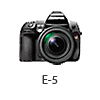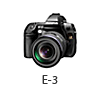Question :
What differentiates the E-5 from the E-3?
Answer:
The following table describes the differences:
|
 |
 |
| Lens mount |
Four Thirds Mount |
| Memory |
CompactFlash
(Type I, UDMA-compatible)
SD Memory Card
(SDHC, SDXC compatible) |
CompactFlash (Type I, II),
Micro drive, xD Picture Card |
| Image processor |
TruePic V+ |
TruePic III |
| Effective pixels number |
12.3 million pixels |
10.1 million pixels |
| Monitor type |
HyperCrystal LCD (semi-transmissive TFT color LCD) |
| Monitor size |
3.0 inches |
2.5 inches |
| Monitor total no. of pixels |
920,000 dots (VGA) |
230,000 dots |
| Movable monitor |
Available |
| Viewfinder field of view/magnification |
100 % / 1.15x |
| Image stabilizer |
5 EV steps (in maximum effect) |
| Imager AF |
Available |
Not available |
| Art filter |
| Multi exposure |
| Multi aspect |
| Panorama combining shooting |
Not available |
| Shooting movies |
Available |
Not available |
| Menu languages |
34 languages including Japanese and English |
2 languages (Japanese, English)
* One language can be added using OLYMPUS Master. |
| Copyright settings |
Available |
Not available |
| Built-in flash |
Available |
| HDMI output connector |
Available |
Not available |
| Stereo microphone jack |
| Body material |
Magnesium alloy |
| Dimensions |
142.5 mm (W) x 116.5 mm (H) x 74.5 mm (D)/
5.6" (W) x 4.6" (H) x 2.9" (D) |
| Release date |
October 2010 |
November 2007 |
Question :
I would like to use a commercially available PL filter. Which type should I use?
Answer:
You can use a circular-type PL filter (C-PL) if you would like to use a commercially available filter.
Question :
The brightness of the LCD monitor changes sometimes when I move my camera. Why is this happening?
Answer:
The camera adjusts the brightness automatically according to the surrounding brightness.
By default, the AUTO BRIGHTNESS setting is ON.
When AUTO BRIGHTNESS is ON, the illumination sensor measures the surrounding brightness and automatically adjusts the brightness of the LCD monitor for optimal viewing.
If you want to keep a certain brightness, press the MENU button, and then select  (Setup Menu). In (Setup Menu). In  (Monitor brightness adjustment), set AUTO BRIGHTNESS to OFF. (Monitor brightness adjustment), set AUTO BRIGHTNESS to OFF.
Question :
What are the compression rates and what size are the image files in each record mode?
Answer:
【 Still pictures 】
The following table shows the approximate values when shooting still pictures in the 4:3 aspect ratio.
| Record mode |
Compression rate |
Number of pixels |
File format |
Number of storable pictures in a 1GB SD/SDHC card |
File size (approx.) |
| RAW |
Lossless compression |
4032 x 3024 |
ORF |
54 |
14MB |
| Large |
SF (SuperFine) |
1/2.7 |
JPEG |
101 |
8.4MB |
F
(Fine) |
1/4 |
145 |
5.9MB |
N
(Normal) |
1/8 |
320 |
2.7MB |
B
(Basic) |
1/12 |
477 |
1.8MB |
| Middle |
SF (SuperFine) |
1/2.7 |
3200 x 2400 |
154 |
5.6MB |
F
(Fine) |
1/4 |
255 |
3.4MB |
N
(Normal) |
1/8 |
504 |
1.7MB |
B
(Basic) |
1/12 |
747 |
1.2MB |
| SF (SuperFine) |
1/2.7 |
2560 x 1920 |
269 |
3.2MB |
F
(Fine) |
1/4 |
395 |
2.2MB |
N
(Normal) |
1/8 |
776 |
1.1MB |
B
(Basic) |
1/12 |
1143 |
0.8MB |
| SF (SuperFine) |
1/2.7 |
1600 x 1200 |
673 |
1.3MB |
F
(Fine) |
1/4 |
993 |
0.9MB |
N
(Normal) |
1/8 |
1893 |
0.5MB |
B
(Basic) |
1/12 |
2753 |
0.4MB |
| Record mode |
Compression rate |
Number of pixels |
File format |
Number of storable pictures in a 1GB SD/SDHC card |
File size (approx.) |
| Small |
SF (SuperFine) |
1/2.7 |
1280 x 960 |
JPEG |
1044 |
0.9MB |
F
(Fine) |
1/4 |
1514 |
0.6MB |
N
(Normal) |
1/8 |
2884 |
0.3MB |
B
(Basic) |
1/12 |
4038 |
0.3MB |
| SF (SuperFine) |
1/2.7 |
1024 x 768 |
1594 |
0.6MB |
F
(Fine) |
1/4 |
2243 |
0.4MB |
N
(Normal) |
1/8 |
4038 |
0.3MB |
B
(Basic) |
1/12 |
5507 |
0.2MB |
| SF (SuperFine) |
1/2.7 |
640 x 480 |
3563 |
0.3MB |
F
(Fine) |
1/4 |
5048 |
0.2MB |
N
(Normal) |
1/8 |
8654 |
0.2MB |
B
(Basic) |
1/12 |
10096 |
0.1MB |
Note:
| - |
The same image (Olympus' standard image) is used to calculate the number of storable pictures and file size in each mode. |
| - |
The number of storable pictures depends on the image quality and the type of memory card. |
| - |
The number of storable pictures in this table differs from the number of remaining pictures displayed on the LCD. This table shows the approximate number, but the camera shows the maximum (up to 9999). |
【 Movies 】
| Record mode |
Image size |
Frame rate
(frames per second) |
Recording time
in a 2 GB SD/SDHC card |
| HD |
1280 × 720 (16:9) |
30fps |
approx. 7 min. |
| SD |
640 × 480 (4:3) |
30fps |
approx. 14 min. |
Note:
| - |
The maximum file size of a movie is 2 GB. This is a limitation of the AVI file format. |
| - |
A Speed Class 6 SD or SDHC card is recommended for movie recording. |
| - |
When shooting movies with an Art Filter, the frame rate varies based on the selected filter. Please note that sound is not recorded when shooting in DIORAMA mode. This is because DIORAMA shoots images at a slow frame rate and increases the speed during playback. |
| - |
In movie mode, IMAGE STABILIZER uses electronic stabilization. With this function, the recorded image is slightly enlarged. |
Question :
Which types of memory cards can I use?
Answer:
The E-5 can use SD cards (SDHC, SDXC) and CompactFlash ® (Type I, UDMA-compatible). You can also copy images from one type of card to another inside the camera.
Question :
Where can I find the instruction manual for my camera?
Answer:
You can either read online or download the instruction manual for your camera.
See the following Web page to find the available manuals:
 Download Manuals Download Manuals
Question :
Where can I find information on how to use the [ib] software?
Answer:
Answers to the most frequently asked questions about [ib] are collected here.
Detailed documentation of the software's functions is available in the application's Help file. To access the Help file, launch [ib] and choose ib Help from the Help menu.
Question :
For how many steps of shutter speed does the E-5's Image Stabilizer compensate?
Answer:
The effect of the image stabilizer is equivalent to up to five shutter speed steps, according to Olympus' testing conditions. The value varies depending on the lens and shooting conditions. For example, when you shoot at a shutter speed of 1/15, the Image Stabilizer compensates for camera shake equivalent to 1/500.
Note:
The Image Stabilizer will not activate at shutter speeds of greater than two seconds. Stabilization may not be possible when the camera is severely shaken.
|


